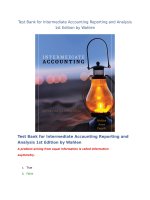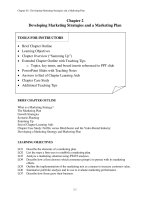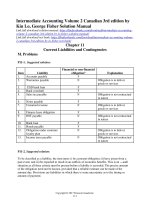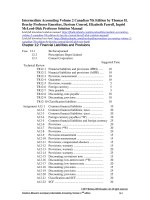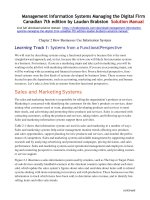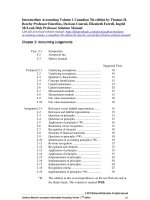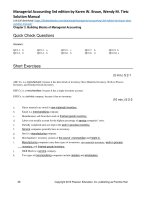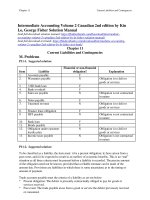Intermediate accounting volume 2 canadian 3rd edition by lo fisher solution manual
Bạn đang xem bản rút gọn của tài liệu. Xem và tải ngay bản đầy đủ của tài liệu tại đây (3.22 MB, 128 trang )
Intermediate Accounting Volume 2 Canadian 3rd edition by
Kin Lo, George Fisher Solution Manual
Link full download solution manual: />Link full download test bank: />
Chapter 11
Current Liabilities and Contingencies
M. Problems
P11-1. Suggested solution:
Financial or non-financial
obligation?
F
N
Item
Liability
1.
Accounts payable
2.
Warranties payable
3.
4.
5.
USD bank loan
Bank overdraft
Sales tax payable
F
F
N
6.
7.
Notes payable
Unearned revenue
F
N
8.
9.
Finance lease obligation
HST payable
F
N
10.
11.
12.
Bank loan
Bonds payable
Obligation under customer
loyalty plan
Income taxes payable
F
F
N
13.
N
Explanation
Obligation is to deliver
goods or services
Obligation is not contractual
in nature
Obligation is to deliver
goods or services
Obligation is not contractual
in nature
Obligation is to deliver
goods or services
Obligation is not contractual
in nature
P11-2. Suggested solution:
To be classified as a liability, the item must: i) be a present obligation; ii) have arisen from a
past event; and iii) be expected to result in an outflow of economic benefits. This is an ―and‖
situation as all three criteria must be present before a liability is recorded. The precise amount
of the obligation need not be known, provided that a reliable estimate can be made of the
amount due. Provisions are liabilities in which there is some uncertainty as to the timing or
amount of payment.
Copyright © 2017 Pearson Canada Inc.
11-1
ISM for Lo/Fisher, Intermediate Accounting, Vol. 2, Third Canadian Edition
Trade accounts payable meet the criteria of a liability as set out below:
* Present obligation: The debtor is presently contractually obliged to pay for goods or
services received.
* Past event: The trade payable arose from a good or service the debtor previously received or
consumed.
* Outflow of economic benefits: Trade payables are typically settled in cash—an outflow
of economic benefits.
P11-3. Suggested solution:
a. Provisions are liabilities in which there is some uncertainty as to the timing or amount
of payment.
b. Financial liabilities are contracts to deliver cash or other financial assets to another party.
They differ from non-financial liabilities as the latter category is typically settled through
the provision of goods or services.
c. A non-exhaustive list of financial liabilities includes accounts payable; bank loans;
notes payable; bonds payable; and finance leases. A non-exhaustive list of non-financial
obligations includes warranties payable; unearned revenue; and income taxes payable.
P11-4. Suggested solution:
a. The three broad categories of liabilities are:
1. Financial liabilities held for trading
2. Other financial liabilities
3. Non-financial liabilities
b.
* Held-for-trading liabilities are initially recognized at fair value.
* Other financial liabilities are initially reported at fair value minus the transaction costs
directly resulting from incurring the obligation.
* The initial measurement of non-financial liabilities depends on their nature. For instance,
warranties are recorded at management’s best estimate of the downstream cost of meeting
the entity’s contractual obligations, while prepaid magazine subscription revenue is
valued at the consideration initially received.
c.
* Held-for-trading liabilities are subsequently recognized at fair value.
* Other financial liabilities are subsequently measured at amortized cost using the effective
rate method.
* Non-financial liabilities are subsequently measured at the initial obligation less the
amount earned to date or satisfied to date through performance. For example, a publisher
that received $750 in advance for a three-year subscription and has delivered the
magazine for one year would report an obligation of $500 ($750 – $250).
Copyright © 2017 Pearson Canada Inc.
11-2
Chapter 11: Current Liabilities and Contingencies
P11-5. Suggested solution:
Item Liability
Current or
noncurrent
liability, or
potentially
both?
C
B
1.
2.
Accounts payable
Warranties payable
3.
Deposits
B
4.
5.
6.
Bank overdraft
Sales tax payable
Bank loan maturing in five
years was in default during the
year; before year-end, the
lender grants a grace period
that extends 12 months after
the balance sheet date
Five-year term loan, amortized
payments are payable annually
C
C
N
8.
Unearned revenue
B
9.
Finance lease obligation
B
10.
11.
12.
HST payable
90-day bank loan
Bond payable that matures in
two years
C
C
N
7.
B
Explanation
The obligation that is expected to be
settled within one year of the balance
sheet date is current, the balance noncurrent
The classification of the deposit as
current or non-current depends upon the
expected settlement date. If less than one
year after the balance sheet date, the
obligation is classified as current
The obligation is reported as a noncurrent liability because the grace period
was granted before the balance sheet date
and extends twelve months after yearend
The principal portion of the payments
due within one year of the balance sheet
date are classified as current, the balance
as non-current
The classification of the obligation as
current or non-current depends upon
when revenue is the expected to be
recognized. If less than one year after the
balance sheet date, the obligation is
classified as current
The principal portion of the payments
due within one year of the balance sheet
date are classified as current, the balance
as non-current
The obligation is reported as non-current
as the maturity date is two years after the
balance sheet date
Copyright © 2017 Pearson Canada Inc.
11-3
ISM for Lo/Fisher, Intermediate Accounting, Vol. 2, Third Canadian Edition
13.
Obligation under customer
loyalty plan
C
14.
15.
Income taxes payable
Bank loan that matures in five
years that is currently in
default
Three-year bank loan that
matures six months after the
balance sheet date
C
C
16.
Classified as current as the entity does
not have the unconditional right to defer
settlement for twelve months after the
reporting period.
C
P11-6. Suggested solution:
Summary journal entries
1. Dr. Inventory
Dr. HST recoverable ($10,000 × 14%)
Cr. Accounts payable ($10,000 + $1,400)
10,000
1,400
2. Dr. Equipment ($20,000 + $500)
Dr. HST recoverable ($20,500 × 14%)
Cr. Accounts payable ($20,500 + $2,870)
20,500
2,870
3. Dr. Cash [$15,000 × (1 + 14%)]
Cr. Sales
Cr. HST payable ($15,000 × 14%)
Dr. Cost of goods sold ($15,000 x 50%)
Cr. Inventory
17,100
4. Dr. Accounts receivable [$20,000 × (1 + 14%)]
Cr. Sales
Cr. HST payable ($20,000 × 14%)
Dr. Cost of goods sold ($20,000 x 50%)
Cr. Inventory
22,800
5. Dr. Accounts payable
Cr. Cash
23,370
6. Dr. HST payable ($12,000 + $2,100 + $2,800)
Cr. HST recoverable ($8,000 + $1,400 + $2,870)
Cr. Cash ($16,900 – $12,270)
16,900
11,400
23,370
15,000
2,100
7,500
7,500
20,000
2,800
10,000
10,000
23,370
Copyright © 2017 Pearson Canada Inc.
11-4
12,270
4,630
Chapter 11: Current Liabilities and Contingencies
P11-7. Suggested solution:
Summary journal entries
1. Dr. Inventory
Dr. HST recoverable ($12,000 × 15%)
Cr. Accounts payable ($12,000 + $1,800)
12,000
1,800
2. Dr. Equipment ($15,000 + $1,000)
Dr. HST recoverable ($16,000 × 15%)
Cr. Accounts payable ($16,000 + $2,400)
16,000
2,400
3. Dr. Cash [$11,000 × (1 + 15%)]
Cr. Sales
Cr. HST payable ($11,000 × 15%)
Dr. Cost of goods sold ($11,000 x 80%)
Cr. Inventory
12,650
4. Dr. Accounts receivable [$20,000 × (1 + 15%)]
Cr. Sales
Cr. HST payable ($20,000 × 15%)
Dr. Cost of goods sold ($20,000 x 80%)
Cr. Inventory
23,000
5. Dr. Accounts payable
Cr. Cash
13,800
6. Dr. HST payable ($22,000 + $1,650 + $3,000)
Cr. HST recoverable ($20,000 + $1,800 + $2,400)
Cr. Cash ($26,650 – $24,200)
26,650
13,800
18,400
11,000
1,650
8,800
8,800
20,000
3,000
16,000
16,000
13,800
Copyright © 2017 Pearson Canada Inc.
11-5
24,200
2,450
ISM for Lo/Fisher, Intermediate Accounting, Vol. 2, Third Canadian Edition
P11-8. Suggested solution:
Summary journal entries
1. Dr. Inventory ($42,000 – $2,000)
Dr. GST recoverable ($40,000 × 5%)
Cr. Accounts payable [$40,000 × (1 + 5%)]
The purchase of inventory for resale is PST exempt.
40,000
2,000
2. Dr. Cash [$30,000 × (1 + 5% + 7%)]
Cr. Sales
Cr. GST payable ($30,000 × 5%)
Cr. PST payable ($30,000 × 7%)
Dr. Cost of goods sold ($30,000 × 2/3)
Cr. Inventory
33,600
3. Dr. Accounts receivable [$60,000 × (1 + 5% + 7%)]
Cr. Sales
Cr. GST payable ($60,000 × 5%)
Cr. PST payable ($60,000 × 7%)
Dr. Cost of goods sold ($60,000 × 2/3)
Cr. Inventory
67,200
4. Dr. GST payable ($20,000 + $1,500 + $3,000)
Dr. PST payable ( $22,000 + $2,100 + $4,200)
Cr. GST recoverable ($21,000 + $2,000)
Cr. Cash ($24,500 + $26,300 – $23,000)
24,500
26,300
Copyright © 2017 Pearson Canada Inc.
11-6
42,000
30,000
1,500
2,100
20,000
20,000
60,000
3,000
4,200
40,000
40,000
23,000
27,800
Chapter 11: Current Liabilities and Contingencies
P11-9. Suggested solution:
Summary journal entries
1. Dr. Inventory
Dr. GST recoverable ($30,000 × 5%)
Cr. Accounts payable [$30,000 × (1 + 5%)]
The purchase of inventory for resale is PST exempt.
30,000
1,500
2. Dr. Cash [$20,000 × (1 + 5% + 5%)]
Cr. Sales
Cr. GST payable ($20,000 × 5%)
Cr. PST payable ($20,000 × 5%)
Dr. Cost of goods sold ($20,000 × 75%)
Cr. Inventory
22,000
3. Dr. Accounts receivable [$50,000 × (1 + 5% + 5%)]
Cr. Sales
Cr. GST payable ($50,000 × 5%)
Cr. PST payable ($50,000 × 5%)
Dr. Cost of goods sold ($50,000 × 75%)
Cr. Inventory
55,000
4. Dr. GST payable ($18,000 + $1,000 + $2,500)
Dr. PST payable ( $14,000 + $1,000 + $2,500)
Cr. GST recoverable ($15,000 + $1,500)
Cr. Cash ($21,500 + $17,500 – $16,500)
21,500
17,500
Copyright © 2017 Pearson Canada Inc.
11-7
31,500
20,000
1,000
1,000
15,000
15,000
50,000
2,500
2,500
37,500
37,500
16,500
22,500
ISM for Lo/Fisher, Intermediate Accounting, Vol. 2, Third Canadian Edition
P11-10. Suggested solution:
Oct. 31,
2019
Dr. Retained earnings
30,000
Cr. Dividends payable on preferred shares
(10,000 sh × $1.00/sh × 2) + (5,000 sh × $2.00/sh)
The preferred shares B are non-cumulative in nature
and as such are not entitled to dividends for 2014 as
they were not declared.
Nov. 30,
2019
Dr. Retained earnings
30,000
50,000
Cr. Dividends payable on common shares
(100,000 sh × $0.50 sh)
Dec. 1,
2019
Dr. Dividends payable on preferred shares
50,000
30,000
Cr. Cash
30,000
Jan. 2, 2020 Dr. Dividends payable on common shares
Cr. Cash
50,000
50,000
P11-11. Suggested solution:
Oct. 31, 2016Dr. Retained earnings
Cr. Dividends payable on preferred shares
(50,000 sh × $2.00/sh) + (25,000 sh × $1.00/sh × 3)
The preferred shares A are non-cumulative in nature and
as such are not entitled to dividends for 2014 or 2015 as
they were not declared.
175,000
Nov. 30, 2016 Dr. Retained earnings
Cr. Common stock dividends distributable
(200,000 sh × 10%/sh × $15.00)
300,000
Dec. 1, 2016
Dr. Dividends payable on preferred shares
Cr. Cash
175,000
Dr. Common stock dividends distributable
Cr. Common shares
300,000
Jan. 2, 2017
Copyright © 2017 Pearson Canada Inc.
11-8
175,000
300,000
175,000
300,000
Chapter 11: Current Liabilities and Contingencies
P11-12. Suggested solution:
Jan. 31
Feb. 15
Feb. 28
Mar. 15
Mar. 31
Apr. 15
Dr. Franchise fee expense
Cr. Royalty fee payable
($50,000 × 5%)
2,500
Dr. Sales and marketing expense
Cr. Royalty fee payable
($50,000 × 2.5%)
1,250
Dr. Royalty fee payable
Cr. Cash
($2,500 + $1,250)
3,750
Dr. Franchise fee expense
Cr. Royalty fee payable
($40,000 × 5%)
2,000
Dr. Sales and marketing expense
Cr. Royalty fee payable
($40,000 × 2.5%)
1,000
Dr. Royalty fee payable
Cr. Cash
($2,000 + $1,000)
3,000
Dr. Franchise fee expense
Cr. Royalty fee payable
($60,000 × 5%)
3,000
Dr. Sales and marketing expense
Cr. Royalty fee payable
($60,000 × 2.5%)
1,500
Dr. Royalty fee payable
Cr. Cash
($3,000 + $1,500)
4,500
Copyright © 2017 Pearson Canada Inc.
11-9
2,500
1,250
3,750
2,000
1,000
3,000
3,000
1,500
4,500
ISM for Lo/Fisher, Intermediate Accounting, Vol. 2, Third Canadian Edition
P11-13. Suggested solution:
a.
Jan. 1, 2016
Dec. 31, 2016
Dec. 31, 2016
Dec. 31, 2016
b.
Jan. 15, 2017
Dr. Franchise agreement
Cr. Cash
Dr. Amortization expense - franchise
Cr. Franchise agreement
($30,000/10 years)
30,000
30,000
3,000
3,000
Dr. Royalty fee expense
Cr. Royalty fee payable
($850,000 × 7%)
59,500
Dr. Sales and marketing expense
Cr. Royalty fee payable
($850,000 × 2%)
17,000
Dr. Royalty fee payable
Cr. Cash
($59,500 + $17,000)
76,500
59,500
17,000
76,500
P11-14. Suggested solution:
a. Summary journal entries
2018 Dr. Cash (6 × $2,000)
Cr. Deferred revenue
12,000
12,000
2018 Dr. Cash (2 × $3,000)
Dr. Deferred revenue (2 × $2,000)
Cr. Revenue (2 × $5,000)
Dr. Cost of goods sold (2 × $2,300)
Cr. Cash
6,000
4,000
2019 Dr. Cash (4 × $3,000)
Dr. Deferred revenue (4 × $2,000)
Cr. Revenue (4 × $5,000)
Dr. Cost of goods sold (4 × $2,300)
Cr. Cash
12,000
8,000
10,000
4,600
4,600
20,000
9,200
9,200
b. The balance in the deferred revenue account as at December 31, 2018 was $8,000 ($12,000 –
$4,000 or $2,000 × 4)
Copyright © 2017 Pearson Canada Inc.
11-10
Chapter 11: Current Liabilities and Contingencies
P11-15. Suggested solution:
1.
Dr. Warranty expense
Cr. Provision for warranty obligations
2,500 × ($5 + $7) = $30,000
30,000
30,000
2.
Dr. Provision for warranty obligations
Cr. Wage expense
6,000
6,000
3. The total provision for warranty obligations that will be reported at year-end is $24,000
($30,000 – $6,000). Of this amount, $6,500 will be reported as a current obligation [(2,500 ×
$5) – $6,000 = $6,500] and the $17,500 balance as a non-current liability (2,500 × $7 =
$17,500) or ($24,000 – $6,500 = $17,500).
4. Companies offer warranties that their products will be free from defects for a specified period
to facilitate the sale of their merchandise.
P11-16. Suggested solution:
The obligation is initially valued at the spot exchange rate evident on the transaction date
and revalued at period end using the period ending spot rate.
May 1,
2016
Dr. Cash (US$140,000 × C$1.02 / US$1.00 )
Cr. Bank loan
Dec. 31,
2016
Dr. Foreign exchange loss
(US$140,000 × (C$1.04 – C$1.02) / US$1.00)
Cr. Bank loan
Copyright © 2017 Pearson Canada Inc.
11-11
142,800
142,800
2,800
2,800
ISM for Lo/Fisher, Intermediate Accounting, Vol. 2, Third Canadian Edition
P11-17. Suggested solution:
The obligation is initially valued at the spot exchange rate evident on the transaction date
and revalued at period end and payment date using the applicable spot rate.
Dec. 15, 2015
Dec. 31, 2015
Jan. 3, 2016
Dr. Supplies expense
(US$5,000 × C$1.04 / US$1.00)
Cr. Trade account payable
5,200
5,200
Dr. Trade account payable
Cr. Foreign exchange gain
(US$5,000 × (C$1.04 – C$1.01) / US$1.00)
150
Dr. Foreign exchange loss
Cr. Trade account payable
(US$5,000 × (C$1.03 – C$1.01) / US$1.00)
Dr. Trade account payable ($5,200 - $150 + $100)
Cr. Cash
(US$5,000 × C$1.03 / US$1.00)
100
150
100
5,150
5,150
P11-18. Suggested solution:
a. Revenue is recognized for the award portion of company-offered rewards when the customer
claims their reward. Revenue is recognized for the award portion of third-party rewards at
the time of sale.
b. The transaction price must be allocated to the sales and award performance obligations
based on their relative stand-alone selling prices.
P11-19. Suggested solution:
Summary journal entries
To recognize the sales-related revenue in 2015
a. Dr. Cash (20,000 × $600)
Cr. Sales
Cr. Provision for manufacturer’s rebates
((20,000 × $50 × 30%)
Dr. Cost of goods sold (20,000 × $350)
Cr. Inventory
12,000,000
To recognize the issuance of the rebate cheques in 2016
b. Dr. Provision for manufacturer’s rebates
Cr. Cash
Copyright © 2017 Pearson Canada Inc.
11-12
11,700,000
300,000
7,000,000
7,000,000
300,000
300,000
Chapter 11: Current Liabilities and Contingencies
P11-20. Suggested solution:
a. Dr. Computer system
Cr. Note payable ($20,000 / 1.04)
Using a BAII PLUS financial calculator
1N, 4 I/Y, 20000 FV, CPT PV PV = –19,231
b. Dr. Interest expense
Cr. Note payable
$19,231 × 4% = $769
19,231
19,231
769
769
c. Dr. Note payable
20,000
Cr. Cash
No entry for interest is required as it had been accrued on December 31, 2014.
20,000
P11-21. Suggested solution:
a. Dr. Automobile
Cr. Note payable
Cr. Cash
40,000
30,000
10,000
b. Dr. Interest expense
Cr. Accrued interest payable
$30,000 × 4% × 184 / 365 = $605 (rounded)
c. Dr. Interest expense
Dr. Accrued interest payable
Dr. Note payable
Cr. Cash ($30,000 + $296 + $605)
$30,000 × 4% × 90 / 365 = $296 (rounded)
Copyright © 2017 Pearson Canada Inc.
11-13
605
605
296
605
30,000
30,901
ISM for Lo/Fisher, Intermediate Accounting, Vol. 2, Third Canadian Edition
P11-22. Suggested solution:
a.
Nov. 15,
2017
Dr. Supplies inventory
Cr. Trade payables
[$5,000 × (100% – 2%)]
4,900
4,900
Nov. 22,
2017
Dr. Equipment—washing machines
8,000
Cr. Notes payable
8,000
Recorded at face value as it is a short-term note and the interest component is
immaterial
Nov. 28,
2017
Dr. Cash
Cr. Notes payable
Nov. 30,
2017
Dr. Interest expense (bank loan)
Cr. Cash ($20,000 × 4% × 3/365 = $7 (rounded))
Dec. 18,
2017
Dr. Supplies inventory
Cr. Trade payables ($4,000 × (100% – 2%))
Dec. 21,
2017
Dr. Equipment—dryers
9,615
Cr. Notes payable ($10,000 / 1.04)
9,615
Using a BAII PLUS financial calculator
1 N, 4 I/Y, 10,000 FV, CPT PV PV = –9,615 (rounded)
4% is an appropriate discount rate to use as the question identifies this as the
market rate of interest for NVL's short-term borrowings
20,000
20,000
7
7
3,920
3,920
Dec. 22, Dr. Trade payables
2017
Dr. Purchase discounts lost
Cr. Cash
4,900
100
Dec. 22, Dr. Trade payables
2017
Cr. Cash
3,920
5,000
3,920
Dec. 31, Dr. Payroll expense
2017
Cr. Cash
Cr. Employee remittances payable
20,000
18,600
1,400
Dec. 31, Dr. Interest expense (bank loan)
2017
Cr. Cash ($20,000 × 4% × 31/365 = $68
(rounded))
68
Dec. 31, Dr. Interest expense (note payable)
2017
Cr. Note payable
[$9,615 × 4% × 11/365 = $12 (rounded)]
12
Copyright © 2017 Pearson Canada Inc.
11-14
68
12
Chapter 11: Current Liabilities and Contingencies
b. When the gross method is used, the payable is recorded at the invoiced amount, as is the
asset acquired. If the discount is taken, the book value of the asset acquired is reduced by
an equivalent amount. If the discount is not taken, an adjustment is not required.
When the net method is used, the payable is recorded at the invoiced amount less the
discount, as is the asset acquired. If the discount is taken, an adjustment is not required. If
the discount is not taken, an income statement account ―purchase discounts lost‖ is debited
for the amount of the discount forgone.
From a theoretical perspective, the net method should be used as forgone discounts are a
financing cost. From a practical perspective, the gross method is widely used as it is
simpler to use and as the forgone discounts are usually immaterial.
P11-23. Suggested solution:
Aug. 15
Aug. 18
Aug. 21
Aug. 30
Sept. 20
Sept. 23
Sept. 24
Dr. Equipment—inventory monitoring system
Cr. Notes payable
Recorded at face value as it is a short-term note and the
interest component is immaterial
6,000
6,000
Dr. Cash
Cr. Notes payable
10,000
Dr. Inventory
Cr. Trade payables
8,000
Dr. Interest expense (bank loan)
Cr. Cash ($10,000 × 4% × 14/365 = $15
(rounded))
10,000
8,000
15
15
Dr. Equipment—waste management system
Cr. Notes payable ($8,000 / 1.05)
Using a BAII PLUS financial calculator
1 N, 5 I/Y, 8,000 FV, CPT PV PV = –7,619 (rounded)
5% is an appropriate discount rate to use as the question
identifies this as the market rate of interest for MEI's
unsecured short-term borrowings
7,619
Dr. Inventory
Cr. Trade payables
3,000
Dr. Trade payables ($8,000 + $3,000)
Cr. Inventory ($3,000 x 3%)
Cr. Cash
The discount was lost on the $8,000 payable as the
invoice was outstanding for more than 10 days.
Copyright © 2017 Pearson Canada Inc.
11-15
7,619
3,000
11,000
90
10,910
ISM for Lo/Fisher, Intermediate Accounting, Vol. 2, Third Canadian Edition
Sept. 30
Sept. 30
Sept. 30
Dr. Utilities expense
Cr. Accrued trade payables
1,700
1,700
Dr. Interest expense (bank loan)
Cr. Cash ($10,000 × 4% × 30/365 = $33
(rounded))
33
Dr. Interest expense (note payable)
Cr. Note payable [$7,619 × 5% × 11/365 = $11
(rounded)]
11
33
11
P11-24. Suggested solution:
Maturing obligations are classified as either current or non-current liabilities depending on the
circumstances.
* If a renewal agreement is entered into before year-end, the obligation is classified as a noncurrent liability.
* If the loan is renewed after year-end, but before the statements are approved for issue,
the obligation is classified as a current liability. The renewal is disclosed in the notes to
the financial statements.
* If the loan is not renewed or renewed after the statements are approved for issue,
the obligation is classified as a current liability.
P11-25. Suggested solution:
Loans in default are classified as either current or non-current liabilities depending on the
circumstances.
* If, before year-end, the lender agrees to a grace period to cure the defaults that extends at
least twelve months after the balance sheet date, the obligation is classified as a noncurrent liability.
* If the lender agrees to a grace period to cure the default after year-end but before the
statements are approved for issue, the obligation is classified as a current liability. Providing
the grace period is for one year or more, the waiver of default is disclosed in the notes to the
financial statements.
* If the lender does not agree to a grace period or its approval is received after the
statements are approved for issue, the obligation is classified as a current liability.
Copyright © 2017 Pearson Canada Inc.
11-16
Chapter 11: Current Liabilities and Contingencies
P11-26. Suggested solution:
a.
Jan. 1
Apr. 1
Nov. 1
b.
Dec. 31
Dec. 31
Dr. Cash
Cr. Deferred revenue
10,000 × $180 = $1,800,000
1,800,000
Dr. Cash
Cr. Deferred revenue
5,000 × $180 = $900,000
900,000
Dr. Cash
Cr. Deferred revenue
12,000 × $180 = $2,160,000
2,160,000
1,800,000
900,000
2,160,000
Dr. Deferred revenue
Cr. Revenue
945,000
Dr. Magazine expense
Cr. Cash
378,000
945,000
378,000
$180/36 = $5 in revenue per magazine sold
Sales
Number sold—
Months delivered— Revenue—A × B ×
Expense—A × B ×
date
A
B
$5
$2
Jan. 1
10,000
12
$600,000
$240,000
Apr. 1
5,000
9
225,000
90,000
Nov. 1
12,000
2
120,000
48,000
Revenue and expense to be recognized
$945,000
$378,000
Copyright © 2017 Pearson Canada Inc.
11-17
ISM for Lo/Fisher, Intermediate Accounting, Vol. 2, Third Canadian Edition
P11-27. Suggested solution:
a.
Jan. 1
Feb. 1
Aug. 1
Dec. 1
b.
Dec. 31
Dec. 31
Dr. Cash
Cr. Deferred revenue
8,000 × $72 = $576,000
576,000
Dr. Cash
Cr. Deferred revenue
6,000 × $72 = $432,000
432,000
Dr. Cash
Cr. Deferred revenue
9,000 × $72 = $648,000
648,000
Dr. Cash
Cr. Deferred revenue
12,000 × $72 = $864,000
864,000
Dr. Deferred revenue
Cr. Revenue
1,314,000
Dr. Production and delivery expense
Cr. Cash
576,000
432,000
648,000
864,000
1,314,000
657,000
657,000
$72/12 = $6 in revenue per month per newspaper subscription sold
Sales
Number sold— Months delivered— Revenue—A × B × Expense—A × B ×
date
A
B
$6
$3
Jan. 1
8,000
12
$ 576,000
$288,000
Feb. 1
6,000
11
396,000
198,000
Aug. 1
9,000
5
270,000
135,000
Dec. 1
12,000
1
72,000
36,000
Revenue and expense to be recognized
$1,314,000
$657,000
Copyright © 2017 Pearson Canada Inc.
11-18
Chapter 11: Current Liabilities and Contingencies
P11-28. Suggested solution:
To recognize the provision in 2017
a. Dr. Warranty expense
Cr. Provision for warranty payable
[$4,800,000 × (1% + 2% + 2%)]
To recognize partial satisfaction of the warranty obligation in 2017
Dr. Provision for warranty payable
Cr. Parts inventory
Cr. Wage expense
To recognize the provision in 2018
Dr. Warranty expense
Cr. Provision for warranty payable
($5,400,000 × 7%)
To recognize partial satisfaction of the warranty obligation in 2018
Dr. Provision for warranty payable
Cr. Parts inventory
Cr. Wage expense
b.
240,000
240,000
240,000
150,000
90,000
378,000
378,000
300,000
180,000
120,000
The balance in the warranty payable account as at December 31, 2018 was $338,000
as set out in the T-account that follows:
Claims 2017
Claims 2018
Provision for Warranty Payable
260,000 Balance Dec. 31, 2016
240,000 Provision 2017
240,000
378,000 Provision 2018
300,000
338,000 Balance Dec. 31, 2018
Copyright © 2017 Pearson Canada Inc.
11-19
ISM for Lo/Fisher, Intermediate Accounting, Vol. 2, Third Canadian Edition
P11-29. Suggested solution:
The obligation is initially valued at the spot exchange rate evident on the transaction date and
revalued at period end using the period ending spot rate. Interest is charged to expense at the
average rate for the period, rather than the spot raid paid at time of payment. The difference is
recognized as a gain or loss on the income statement.
Dec. 1, 2018
Dec. 31,
2018
Dec. 31,
2018
Dr. Cash (US$1,000,000 × C$1.08 / US$1.00)
Cr. Bank loan
Dr. Interest expense
(US$1,000,000 × 5.0% × 31/365× C$1.09 / US$1.00)
Dr. Foreign exchange loss
Cr. Cash
(US$1,000,000 × 5.0% × 31/365× C$1.10 /
US$1.00)
Dr. Foreign exchange loss
(US$1,000,000 × (C$1.10 – C$1.08) / US$1.00)
Cr. Bank loan
1,080,000
1,080,000
4,629
42
4,671
20,000
20,000
P11-30. Suggested solution:
a. As per Canadian Tire Corporation, Limited’s balance sheet as at December 28, 2013,
the company reported current liabilities totaling $4,322.1 million categorized as follows:
Type of liability
Amount owing on Dec. 28, 2013 – in $millions
Bank indebtedness
$
69.0
Deposits
1,178.4
Trade and other payables
1,817.4
Provisions
196.1
Short-term borrowings
120.3
Loans payable
611.2
Income taxes payable
57.5
Current portion of long-term debt
272.2
Total current liabilities
$4,322.1
b. As per Note 21, the categories of provisions reported by Canadian Tire follow:
Amount owing on Dec. 28, 2013 – in $millions
Total
Long-term
Current
Sales and warranty returns
$109.5
$ 4.1
$105.4
Site restoration and decommissioning
32.4
23.0
9.4
Onerous contracts
3.2
0.2
3.0
Customer loyalty
71.2
1.4
69.8
Other
18.0
9.5
8.5
Total
$234.3
$38.2
$196.1
Type of provision
Copyright © 2017 Pearson Canada Inc.
11-20
Chapter 11: Current Liabilities and Contingencies
c. As per Note 23, Canadian Tire reports its commercial paper at amortized cost.
d. Canadian Tire reported $7,977.8 million in current assets at December 28, 2013. Its
current ratio was thus $7,977.8 / $4,322.1 = 1.85:1 and its working capital was $7,977.8
million - $4,322.1 million = $3,655.7 million.
P11-31. Suggested solution:
Summary journal entries
To recognize the flight-related revenue in 2015
a. Dr. Cash
Cr. Flight revenue
Cr. Unearned revenue (award points)
8,000,000
7,910,000
90,000
To recognize reward point revenue in 2016
b. Dr. Unearned revenue (award points)
Cr. Award revenue
36,000
To recognize reward point revenue in 2017
b. Dr. Unearned revenue (award points)
Cr. Award revenue
45,000
36,000
45,000
Supporting computations and notes
- 6,000,000 miles are expected to be redeemed (8,000,000 × 75% = 6,000,000). This translates
into 500 flights (6,000,000 / [(15,000 + 25,000) / 2] = 300).
- To obtain the amount of reward revenue to recognize, the denominator is the number of miles
expected to be redeemed rather than the number awarded. ($90,000 / 300 flights = $300).
- 120 reward flights are redeemed in 2016. (120 / 300 × $90,000 = $36,000).
- 150 reward flights are redeemed in 2017. (150 / 300 × $90,000 = $45,000).
Copyright © 2017 Pearson Canada Inc.
11-21
ISM for Lo/Fisher, Intermediate Accounting, Vol. 2, Third Canadian Edition
P11-32. Suggested solution:
Summary journal entries
To recognize the sales-related revenue in 2018
a. Dr. Cash
Cr. Sales (given)
Cr. Unearned revenue (award points - given)
Dr. Cost of goods sold [14,895,000 / (1 + 50%)]
Cr. Inventory
To recognize premium revenue in 2019
b. Dr. Unearned revenue (award points)
Cr. Sales
Dr. Cost of goods sold [30,000 / (1 + 50%)]
Cr. Inventory
To recognize premium revenue in 2020
b. Dr. Unearned revenue (award points)
Cr. Sales
Dr. Cost of goods sold [45,000 / (1 + 50%)]
Cr. Inventory
15,000,000
14,895,000
105,000
9,930,000
9,930,000
30,000
30,000
20,000
20,000
45,000
45,000
30,000
30,000
Supporting computations and notes
- 3,000,000 points are redeemed in 2020. (3,000,000 / 1,000 × $10 = $30,000).
- 4,500,000 points are redeemed in 2021. (4,500,000 / 1,000 × $10 = $45,000).
c. Companies offer incentive programs to increase sales.
P11-33. Suggested solution:
Recall that the amount to be reported as a current liability is any accrued interest payable at
balance sheet date plus the principal amount due within the twelve months immediately
following the balance sheet date. If the loan becomes payable on demand due to a default by the
borrower, the balance of the loan plus accrued interest is normally reported as a current
liability. An exception to this requirement is made when the lender agrees before the statement
date to waive the default for a period of at least one year after the balance sheet date.
Copyright © 2017 Pearson Canada Inc.
11-22
Chapter 11: Current Liabilities and Contingencies
The first step in answering this question it to create a loan amortization schedule matching the
payment due date:
Date
Jan. 1, 2016
Dec. 31, 2016
Dec. 31, 2017
Loan amortization schedule – payments due December 31
Interest expense
Payment
Loan reduction
$160,000 (a)
130,460 (b)
$898,508
898,508
$738,508
768,048
Loan balance
$4,000,000
3,261,492
2,493,444
(a) $4,000,000 × 4% = $160,000
(b) $3,261,492 × 4% = $130,460 (rounded)
Scenario 1 – the amount to be reported as a current liability is the $768,048 principal portion of
the payment next due December 31, 2017. (Principal amount due within twelve months of the
balance sheet date; no accrued interest payable).
Scenario 2 – the loan was in default as at year end and as such $4,160,000 should be reported as
a current liability ($4,000,000 principal portion + $160,000 interest).
Loan amortization schedule – payments due January 1
Interest expense Payment Loan reduction Loan balance including accrued
interest
Jan. 1, 2016
$4,000,000
Dec. 31, 2016
$160,000 (a)
4,160,000
Jan. 1, 2017
$898,508
$898,508
3,261,492
Dec. 31, 2017
130,460 (b)
3,391,952
(a) $4,000,000 × 4% = $160,000
(b) $3,261,492 × 4% = $130,460 (rounded)
Scenario 3 – the amount to be reported as a current liability is the $898,508 payment due on
January 1, 2017. This includes the $160,000 in accrued interest plus the $738,508 principal
portion of the payment. (Principal amount due within twelve months of the balance sheet
date plus accrued interest payable).
Scenario 4 – The grace period was not granted by the lender until after year-end so $4,160,000
should be reported as a current liability ($4,000,000 principal portion + $160,000 interest). As
the covenant waiver was received before the financial statements were approved for acceptance,
and as the grace period extended more than twelve months past the balance sheet date, this
information may be disclosed in the notes to the financial statements as a non-adjusting event.
Copyright © 2017 Pearson Canada Inc.
11-23
ISM for Lo/Fisher, Intermediate Accounting, Vol. 2, Third Canadian Edition
P11-34. Suggested solution:
a.
Dr. Cash
Cr. Earned revenue
(1,000 × $5,000 = $5,000,000)
5,000,000
Dr. Cost of goods sold
Cr. Inventory
[$5,000,000 / (1 + 25%) = $4,000,000]
4,000,000
5,000,000
4,000,000
Dr. Warranty expense
Cr. Provision for warranty payable
(1,000 × $400 = $400,000)
400,000
Dr. Provision for warranty payable
Cr. Parts inventory
Cr. Wage expense
170,000
400,000
50,000
120,000
b.
Dr. Cash
Cr. Earned revenue
(1,000 × $5,000 = $5,000,000)
5,000,000
Dr. Cost of goods sold
Cr. Inventory
[$5,000,000 / (1 + 25%) = $4,000,000]
4,000,000
Dr. Warranty expense
Cr. Parts inventory
Cr. Wage expense
5,000,000
4,000,000
170,000
50,000
120,000
c. The cash basis cannot normally be used to account for warranty expenses as it does not
properly match expenses to revenues. In the example above, 2018’s profitability is overstated
$230,000 ($400,000 – $170,000) when the cash basis is used.
d. If management’s provision subsequently proves to be incorrect, the change in estimate is
adjusted for prospectively in the manner discussed in Chapter 3. Essentially Stanger will
debit warranty expense for an additional $70,000 in 2019 when the new information
(claims in excess of the provision) becomes known. Stanger is not required to restate
2018’s results as this is a change in estimate, rather than an error.
Copyright © 2017 Pearson Canada Inc.
11-24
Chapter 11: Current Liabilities and Contingencies
P11-35. Suggested solution:
a. Sales occurred evenly during the year, therefore in 2018 GHF earned, on average, six
months of revenue on the maintenance contracts. As per the chart below, GHF earned
revenues of $14,520.
a.
Photocopiers
# of contracts sold
$ value of contracts sold
Revenue earned (%)*
Revenue earned ($)
Unearned revenue ($)
One
year
$240
24
$5,760
50%
$2,880
$2,880
Two
year
$420
12
$5,040
25%
$1,260
$3,780
Three Contract Revenue
year
value
earned
$600
36
$21,600
$32,400
2
16 / 3 %
$3,600
$7,740
$18,000
Fax machines
# of contracts sold
$ value of contracts sold
Revenue earned (%)
Revenue earned ($)
Unearned revenue ($)
$180
24
$4,320
50%
$2,160
$2,160
$320
24
$7,680
25%
$1,920
$5,760
$450
36
$16,200
16⅔%
$2,700
$13,500
Unearned
revenue
$24,660
$28,200
$6,780
$60,600
$14,520
$21,420
$46,080
* 6 months earned / 12 month contract = 50%; 6 month / 24 month contract = 25%; 6 month /
36 month contract = 16⅔%
b. and c. Deferred revenue is $46,080 ($60,600 – $14,520 = $46,080). Of this, the remaining
services to be provided under the one-year contract are current liabilities and the services to
be provided in the next 12 months under the two- and three-year contracts are current
liabilities. As per the chart below, $24,000 of GHF’s deferred revenue should be reported
as a current liability and $22,080 reported as a non-current liability.
b. and c.
Total deferred
Current
Non-current
Photocopiers
One year
Two year*
Three year**
Total
$2,880
$3,780
$18,000
$24,660
$2,880
$2,520
$7,200
$12,600
$0
$1,260
$10,800
$12,060
Fax machines
One year
Two year***
Three year****
Total
Total
$2,160
$5,760
$13,500
$21,420
$46,080
$2,160
$3,840
$5,400
$11,400
$24,000
$0
$1,920
$8,100
$10,020
$22,080
Copyright © 2017 Pearson Canada Inc.
11-25
